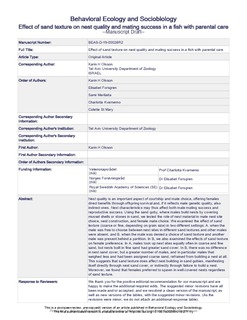| dc.description.abstract | Nest quality is an important aspect of courtship and mate choice, offering females direct benefits through offspring survival and, if it reflects male genetic quality, also indirect ones. Nest characteristics may thus affect both male mating success and reproductive success. Using the sand goby, where males build nests by covering mussel shells or stones in sand, we tested the role of nest material in male nest site choice, nest construction, and female mate choice. We examined the effect of sand texture (coarse or fine, depending on grain size) in two different settings: (A) when the male was free to choose between nest sites in different sand textures and other males were absent, and (B) when the male was denied a choice of sand texture and another male was present behind a partition. In (B), we also examined the effects of sand texture on female preference. In (A), males took up nest sites equally often in coarse and fine sand, but nests built in fine sand had greater sand cover. In (B), there was no difference in nest sand cover, but a greater number of males, and in particular males that weighed less and had been assigned coarse sand, refrained from building a nest at all. This suggests that sand texture does affect nest building in sand gobies, manifesting itself directly through nest sand cover, or indirectly through failure to build a nest. Moreover, we found that females preferred to spawn in well-covered nests regardless of sand texture. Nests offer eggs and offsp ring protection from predators and inclement weather, but building material may af fect both the Properties of the nest and the quality of the construction. Here, we presented male sand gobies with nest sites in either fine-grained or coarse- grained sand, assessed the sand cover of the nest, and allowed females to spawn. We found that grain size influenced the amount of sand cover on the nest and af fected the fraction of males that refrained from building a nest. Female spawning decision depended on the amount of sand cover, but neither males nor females expressed a preference for sand texture. Our results show that nest material is an important but indirect aspect of mating success, which may influence habitat utilization in the wild. Gobiidae, Mate choice, Nest building, Reproduction, Sand goby | nb_NO |
